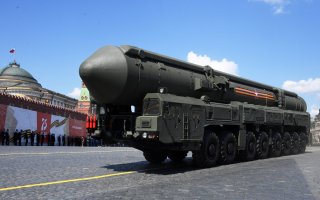by Kris Osborn

Here's What You Need to Know: Russia’s addition of new low-yield tactical nuclear weapons is putting pressure on the United States.
The U.S. must massively “revise” its nuclear weapons-oriented 21st-Century Strategic Deterrence Theory to reinvigorate its arsenal of current and future weapons of mass destruction as a way to stay in front of fast-modernizing rivals, the Commander of U.S. Strategic Command said.
Adm. Charles Richard told a prominent think tank that the U.S. must quickly and efficiently prepare to face two major nuclear-armed rivals in the coming years, citing Chinese and Russian nuclear-weapons modernization as well as fast-emerging threats posed by North Korea and Iran.
Having not faced a major nuclear rival in decades, the U.S. needs to fortify and strengthen its deterrence posture through the construction of new nuclear-weapons and maintenance of current systems, Richard said, according to a Pentagon report.
"Given Russia and China's expanding capabilities in increasingly aggressive behavior, and those posed by nuclear North Korea and possibly Iran, we must reinvigorate the national conversation on the importance of strategic deterrence," Richard told the Center for Strategic and International Studies.
The fundamental concept of deterrence theory is of course grounded upon the premise that the massive amount of destructive power contained in nuclear weapons help, if even somewhat paradoxically, keep peace and prevent war. The current climate, however, is one in which major rivals such as Russia have built new low-yield nuclear weapons and, as Richard put it, blurred the line between conventional and nuclear weapons. This blurring, some suggest, could lower the threshold to nuclear war of some kind.
Russia’s addition of new low-yield tactical nuclear weapons is likely one reason why the Trump administration’s Nuclear Posture Review has inspired the U.S. to create new, low-yield sea-launched nuclear-armed cruise missiles and ballistic missiles.
"Our post-Cold War experiences of operating in uncontested domains are over. Our adversaries took advantage of this period, emboldened … their aggressive behavior, expanded their capabilities and reconsidered their tactics and strategies."
What would it mean to revise deterrence theory?
Perhaps an even larger nuclear arsenal than that which is currently planned? Richard could be referring to a number of possibilities, including the continued acceleration of the Pentagon’s new ICBM program, Ground-Based Strategic Deterrent. DoD plans to build as many as 400 new, more resilient, reliable and accurate ICBMs to replace the 1960s-era Minuteman IIIs. As part of this strategy, Richard also stressed the importance of upgrading and maintaining the Minuteman IIIs for the purpose of preventing a lapse in weaponry as GBSD comes online.
It may also be possible that Richard intends to advocate for the Pentagon to acquire larger numbers of its now-in-development SLBM, Submarine Launched Ballistic Missile. This nuclear-armed SLBM has already been engineered as a new, lower-yield variant of the well known Trident II D5 weapon.
No comments:
Post a Comment